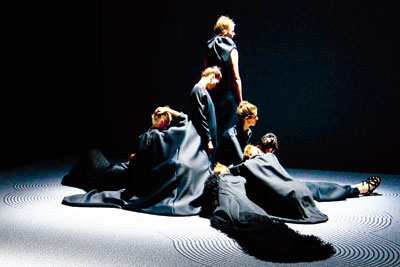 Anna Zhao anna.whizh@yahoo.com A FASHION design exhibition showcasing works by 35 designers from 13 countries is now open at OCT Art and Design Gallery in Nanshan District through the end of July. Themed “The Future of Fashion Is Now,” the exhibition aims to introduce trends in the forefront of fashion design through works of both accomplished designers and emerging young designers. With support from the Dutch Culture Center for International Cooperation, the Shenzhen exhibition is the second stop of “The Future of Fashion Is Now” exhibition held in Shanghai last year, but has added five Chinese designers’ works commissioned by the Han Nefkens Fashion on the Edge program. Some designs are collections from the Museum Boijmans Van Beuningen in the Netherlands. Using costumes, pictures, videos and installation art, the exhibition explores the latest development in contemporary fashion design in four aspects: materials, the human figure, new values in the fashion system, and the interaction between fashion and society. The Chinese designers’ works are called “the third eye” for their future-oriented design while keeping their Chinese cultural tradition. Rather than offering a view of dazzling designs, the exhibition gives a considerable amount of thought to the concerns of young designers in the world — fashion is not just about clothing itself, but also the industry and human society. Designers, with their sharp sense, have resorted to the latest technologies to help express particular visual effects and physical characteristics of their garments. Wearable devices, 3-D printing technology, biological materials and even solar-powered batteries have been utilized in the designer’s experiment for novelty and function. Although popular aesthetic appreciation for female fashion has been dominated by the unified ideal of tall and thin, some designers have challenged that orthodox. Since Japanese designer Rei Kawakubo’s work in 1997 “Lumps and Bumps,” — a configuration of a malformed female body with padded back and buttocks — sent a shockwave through the fashion world and gave rise to the question of whether symmetry is a necessary notion for beauty, many designers have made various attempts to break the chain from the traditional aesthetic standard with designs for different human figures. The movement was represented by works of designers Pyuupiru from Japan, Imme van der Haak from the Netherlands and Minna Palmqvist from Finland. While fashion is often associated with extravagant consumerism, the idea of slow fashion has emerged as a counteraction — a movement that strives for a transparent production, use of local resources, use recycled materials and maximizing the use of materials. “Zen Garden” by design duo Viktor Horstingand and Rolf Snoeren from the Netherlands is a good example in this respect. Another eye-catching item is the work “Made by Rain” by Dutch designer Aliki van der Kruijs. The designer let raindrops create a patterned cloth and rainfall can create different patterns. Many designers are fusing their design practice with certain social purposes — they see fashion as a means of communication: a way of making ideas tangible. These designers put up installations and performances to bring social connections and demonstrate clothing’s potential for social expression. For example, the work “United Kingdom” by Lucy+Jorge Orta tries to elaborate through linked clothing how independent urban dwellers are interacting with each other through social networks. Jose Teunissen, one of the two curators of the exhibition, said that new technological developments and an awareness of sustainability are inspiring young designers from all over the world to explore how local traditions, identity, technology and social engagement can change the fashion world from the inside out. | 
